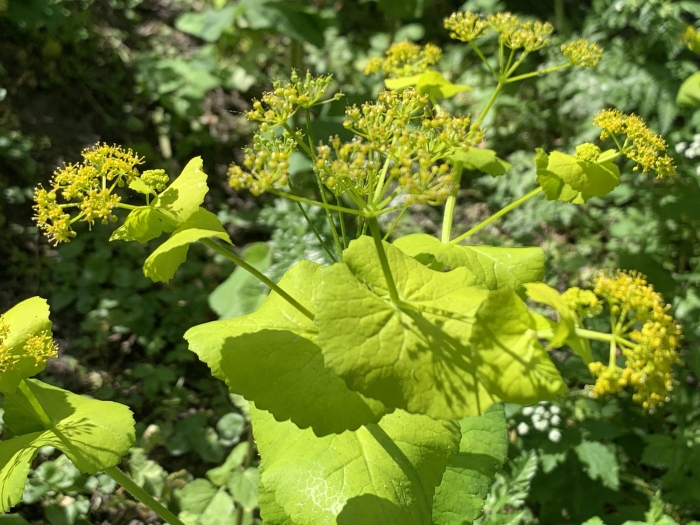Perfoliate Alexanders
(Smyrnium perfoliatum)
Perfoliate Alexanders (Smyrnium perfoliatum)
/
/

Dave Richardson
CC BY 4.0
Image By:
Dave Richardson
Recorded By:
Copyright:
CC BY 4.0
Copyright Notice:
Photo by: Dave Richardson | License Type: CC BY 4.0 | License URL: http://creativecommons.org/licenses/by/4.0/ | Rights Holder: Dave Richardson | Publisher: iNaturalist | Date Created: 2023-05-12T11:53:25Z |

























Estimated Native Range
Summary
Smyrnium perfoliatum, commonly known as Perfoliate Alexanders or Perfoliate Smyrnium, is a deciduous biennial herb that is native to a variety of habitats in Southern and Central Europe, including open woodlands, hedgerows, and roadsides. It typically grows at a moderate rate to a height of 2-3 feet (0.6-0.9 meters) and a width of 1.5-2 feet (0.5-0.6 meters). The plant is characterized by its perfoliate leaves, where the stem appears to grow through the center of the leaf, and its umbels of small, yellow flowers that bloom in the spring and are moderately showy. The foliage is aromatic when crushed.
Perfoliate Alexanders is valued for its historical use as a vegetable and its ornamental foliage. It is suitable for naturalistic plantings and can be used in borders or as part of a cottage garden design. It thrives in full sun to part shade and prefers medium draining clay or loam soils, with consistent moisture. While not commonly found in cultivation, it can be an interesting addition to a garden for those interested in medieval plants or biodiversity. Gardeners should be aware that Smyrnium perfoliatum can self-seed prolifically, potentially becoming a nuisance in some settings. It is also extremely invasive in some parts of the world, so it is crucial to check local regulations before planting it outside its native range.CC BY-SA 4.0
Perfoliate Alexanders is valued for its historical use as a vegetable and its ornamental foliage. It is suitable for naturalistic plantings and can be used in borders or as part of a cottage garden design. It thrives in full sun to part shade and prefers medium draining clay or loam soils, with consistent moisture. While not commonly found in cultivation, it can be an interesting addition to a garden for those interested in medieval plants or biodiversity. Gardeners should be aware that Smyrnium perfoliatum can self-seed prolifically, potentially becoming a nuisance in some settings. It is also extremely invasive in some parts of the world, so it is crucial to check local regulations before planting it outside its native range.CC BY-SA 4.0
Plant Description
- Plant Type: Herb
- Height: 2-3 feet
- Width: 1.5-2 feet
- Growth Rate: Moderate
- Flower Color: Yellow
- Flowering Season: Spring
- Leaf Retention: Deciduous
Growth Requirements
- Sun: Full Sun, Part Shade
- Water: Medium
- Drainage: Medium
Common Uses
Bee Garden, Border Plant, Butterfly Garden, Low Maintenance
Natural Habitat
Native to a variety of habitats in Southern and Central Europe, including open woodlands, hedgerows, and roadsides
Other Names
Common Names: Perfoliate Smyrnium
Scientific Names: , Smyrnium perfoliatum,
GBIF Accepted Name: